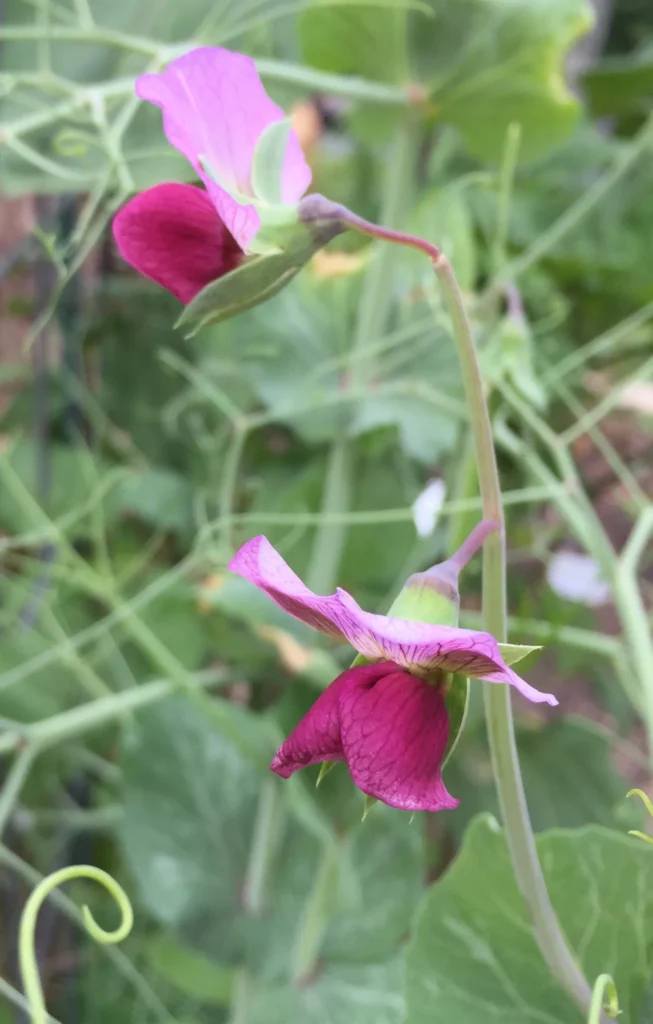Grow Peas, Please!
Thanks to the University of Maryland/Maryland Grows this informative article on why you should grow peas.

Grow Peas
Spring is the time to plant peas! We are nearing the end of our pea-planting window, so if you want to grow them this year, get them in the ground soon. Sowing peas is very weather- and temperature-dependent. There’s a tradition of planting them on St. Patrick’s Day, which is not a bad guide, but obviously, if there’s snow on the ground that day, or it’s pouring rain or freezing cold, you might want to hold off.
Peas are very hardy, and since we’ve had a recent trend of warm late winters (followed by chilly springs), planting them as early as February might actually work, but be ready to throw a protective row cover over the plants when there’s a freeze. But early April is not too late, since it’s often on the cool side well into May. If the weather gets too warm, peas will not bear well, and the vines will dry up.
Soil temperature is also important. Peas can germinate at as low as 40°F, but warmer temperatures (up to 75°F) will aid germination. If the soil is both cold and muddy, pea seeds will likely rot before germinating. Peas grow easily in containers and raised beds, and using these will provide more drainage.
Germinate pea seeds
You can also pre-germinate pea seeds (see instructions on the HGIC “Growing Peas” page). This pretty much guarantees that pea seeds will at least start growing, and once they get going they’ll likely mature. If you don’t have time for pre-germination, just soaking the seeds for a few hours in a container of water immediately before planting will help them get a good start.

Pay attention to the “days to maturity” listed on the seed packet. You can find varieties of peas that mature in as little as 30 days, or as long as 80 days, but most of them will be in the 50-70 day range. Giving them a good head start with the techniques above will help you harvest a crop in time. Shelling peas, snap peas and snow peas can all be grown easily here in Maryland. Pick your favorite! You can also find types that emphasize the growth of tendrils, used most frequently in Asian cooking.
Peas should be planted thickly, 1 to 3 inches apart. The growing plants will tangle together and can support each other, but they’re helped out by using a trellis or fence to climb on. You can also create a trellis out of sticks—just take some small fallen branches and shove them into the ground, overlapping to make a rough structure. Be creative! Place your trellis when you plant your peas, not after they have sprouted, to prevent damage to roots. Read the variety description to find out how long the vines will grow; there are dwarf varieties that top out at less than two feet or long vines that can reach six feet.
Some notes on nomenclature:
- The edible peas you grow in your garden are Pisum sativum. They are often called “sweet peas” because they are sweeter than field peas (see below).
- “Sweet peas” are also a flowering vining plant you may grow as an ornamental, Lathyrus odoratus. Don’t confuse the two when you’re buying seeds! Sweet pea is a lovely plant but not edible, and the seeds may be toxic.
- “Field pea” can refer to Lathyrus hirsutus, also known as Austrian winter pea, which you can buy as cover crop seed. Also not recommended as an edible crop.
- “Field pea” can also refer to the plant known as cowpea, Southern pea, or black-eyed pea (though only some varieties are white with black spots). The scientific name for these is Vigna unguiculata subspecies unguiculata. (Subspecies sesquipedalis is known as yardlong bean or asparagus bean.) Cowpeas are grown more like beans than peas, in summer weather, and they are a great edible crop as well as a forage crop or cover crop.
So the moral of this is, as usual in gardening: know what you’re buying, and pay attention to scientific names. Also, if you want pretty flowers, Pisum sativum is not bad.

By Erica Smith, Montgomery County Master Gardener. Read more posts by Erica.
In addition, if you are looking to buy or sell your home (with or without a garden), contact Gigi today.
Oh by the way, I’m never too busy for any of your referrals!








Recent Comments